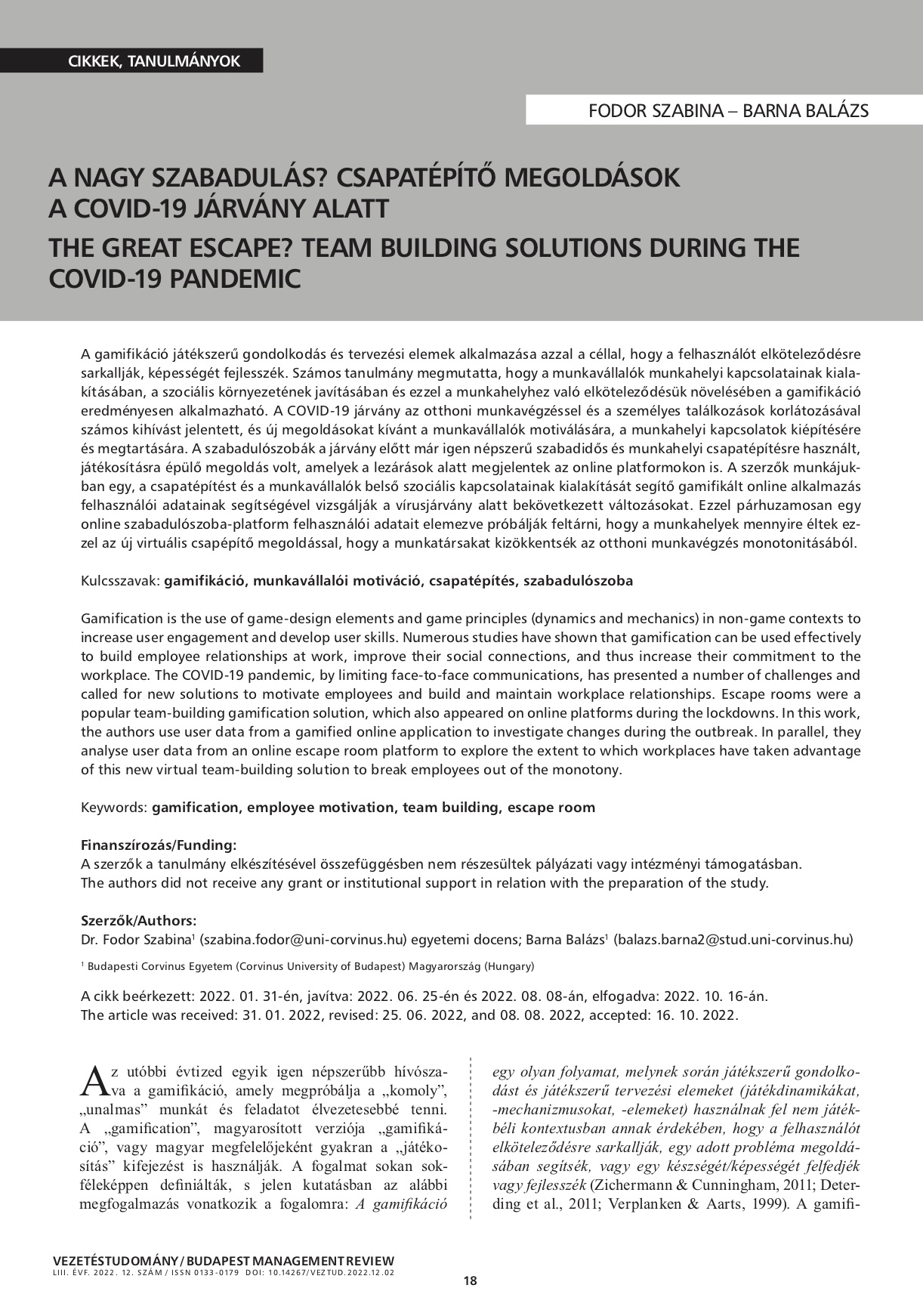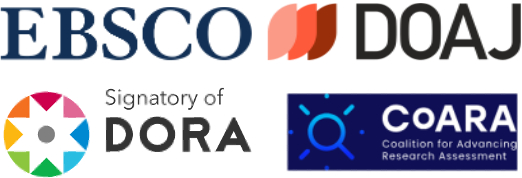A nagy szabadulás? Csapatépítő megoldások a covid-19 járvány alatt
DOI:
https://doi.org/10.14267/VEZTUD.2022.12.02Kulcsszavak:
gamifikáció, munkavállalói motiváció, csapatépítés, szabadulószobaAbsztrakt
A gamifikáció játékszerű gondolkodás és tervezési elemek alkalmazása azzal a céllal, hogy a felhasználót elköteleződésre sarkallják, képességét fejlesszék. Számos tanulmány megmutatta, hogy a munkavállalók munkahelyi kapcsolatainak kialakításában, a szociális környezetének javításában és ezzel a munkahelyhez való elköteleződésük növelésében a gamifikáció eredményesen alkalmazható. A COVID-19 járvány az otthoni munkavégzéssel és a személyes találkozások korlátozásával számos kihívást jelentett, és új megoldásokat kívánt a munkavállalók motiválására, a munkahelyi kapcsolatok kiépítésére és megtartására. A szabadulószobák a járvány előtt már igen népszerű szabadidős és munkahelyi csapatépítésre használt, játékosításra épülő megoldás volt, amelyek a lezárások alatt megjelentek az online platformokon is. A szerzők munkájukban egy, a csapatépítést és a munkavállalók belső szociális kapcsolatainak kialakítását segítő gamifikált online alkalmazás felhasználói adatainak segítségével vizsgálják a vírusjárvány alatt bekövetkezett változásokat. Ezzel párhuzamosan egy online szabadulószoba-platform felhasználói adatait elemezve próbálják feltárni, hogy a munkahelyek mennyire éltek ezzel az új virtuális csapépítő megoldással, hogy a munkatársakat kizökkentsék az otthoni munkavégzés monotonitásából.
Letöltések
Hivatkozások
AI@Work, O. (2020). As Uncertainty Remains, Anxiety and Stress Reach a Tipping Point at Work. Retrieved from https://www.oracle.com/a/ocom/docs/oraclehcm-ai-at-work.pdf
Barna, B. (2020). Gamifikáció hatásának vizsgálata vállalati és oktatási közegben (Doktori értekezés). Budapesti Corvinus Egyetem, Budapest. https://doi.org/10.14267/phd.2020028
Barna, B., & Fodor, S. (2018a). Gamification’s Impact on Employee Engagement: Enhancing Employee Well-Being with a Cloud Based Gamified Team-Building Application. In 2018 6th International Conference on Future Internet of Things and Cloud Workshops (FiCloudW) (pp. 203-208). Piscataway, NJ: IEEE. https://doi.org/ 10.1109/W-FiCloud.2018.00039
Barna, B., & Fodor, S. (2018b). Gamifikált közösségi megoldás használata a kedvezőbb munkahelyi légkör kialakítása érdekében. Vezetéstudomány, 49(3), 2-10. https://doi.org/10.14267/VEZTUD.2018.03.01
Battlejungle. (2021). Battlejungle. Retrieved from https://battlejungle.com/
Bitrián, P., Buil, I., & Catalán, S. (2020). Gamification in sport apps: the determinants of users’ motivation. European Journal of Management and Business Economics, 29(3), 365-381. https://doi.org/10.1108/EJMBE-09-2019-0163
Brouwer, R. (2016). When competition is the loser: The indirect effect of intra-team competition on team performance through task complexity, team conflict and psychological safety. In 49th Hawaii International Conference on System Sciences (HICSS) 2016, (pp. 1348-1357). Piscataway, NJ: IEEE. https://doi.org/10.1109/HICSS.2016.170
Chanana, N. (2021). Employee engagement practices during COVID‐19 lockdown. Journal of Public Affairs, 21(4), e2508. https://doi.org/10.1002/pa.2508
Czeily, T., & Dajnoki, K. (2021). Játékosítás, mint a HR új stratégiai eszköze. ECONOMICA, 12(1), 1-10. https://doi.org/10.47282/economica/2021/12/1-2/9060
DataCamp. (2022). 2022 D ata t rends a nd p redictions. Retrieved from http://www2.datacamp.com/rs/307-OAT-968/images/Data_Trends_and_Predictions_2022.pdf
Deterding, S., Dixon, D., Khaled, R., & Nacke, L. (2011). From game design elements to gamefulness: defining “gamification”. In Proceedings of the 15th international academic MindTrek conference: Envisioning future media environments (pp. 9-15). New York: ACM DL. https://doi.org/10.1145/2181037.2181040
Farkas, F., Jarjabka, Á., Lóránd, B., & Bálint, B. (2013). Munkahelyi motivációk Magyarországon 2013-ban. Vezetéstudomány, 44(10), 12-23. https://doi.org/10.14267/VEZTUD.2013.10.02
Fodor, S., & Barna, B. (2020). An empirical study on key factors affecting user engagement in a gamified team building environment. International Journal of Serious Games, 7(3), 81-95. https://doi.org/10.17083/ijsg.v7i3.355
Fosslien, L. (2021). What You’re Getting Wrong About Burnout. MIT Sloan Management Review. https://sloanreview.mit.edu/article/what-youre-gettingwrong-about-burnout/
Fromann, R. (2012). Gamification – épülőben a Homo Ludens társadalma? Retrieved from http://jatekoslet.hu/letoltes/publikaciok-gamification.pdf
Gómez, S. M., Mendoza, O. E. O., Ramírez, J., & Olivas- Luján, M. R. (2020). Stress and myths related to the COVID-19 pandemic’s effects on remote work. Management Research, 18(4), 401-420. https://doi.org/10.1108/MRJIAM-06-2020-1065
Gray, P., Cross, R., & Arena, M. (2021). Use Networks to Drive Culture Change. MIT Sloan Management Review, 63(2), 51-58. https://sloanreview.mit.edu/article/use-networks-to-drive-culture-change/
Hosseini, C., Humlung, O., Fagerstrøm, A., & Haddara, M. (2022). An experimental study on the effects of gamification on task performance. Procedia Computer Science, 196, 999-1006. https://doi.org/10.1016/j.procs.2021.12.102
Kenéz, A. (2015). Gamification – a játékok alkalmazása a marketingben és a marketingoktatásban. Marketing & Management, 49(4), 36-51. https://journals.lib.pte.hu/index.php/mm/article/view/908
Klerk, J. J. d., Joubert, M., & Mosca, H. F. (2021). Is working from home the new workplace panacea? Lessons from the COVID-19 pandemic for the future world of work. SA Journal of Industrial Psychology, 47(1), 1-14. http://dx.doi.org/10.4102/sajip.v47i0.1883
Korn, O., Boffo, S., & Schmidt, A. (2015). The effect of gamification on emotions-the potential of facial recognition in work environments. In International Conference on Human-Computer Interaction (pp. 489-499). Cham: Springer. https://doi.org/10.1007/978-3-319-20901-2_46
Kovács, T., & Várallyai, L. (2018). A játékosítás az emberi erőforrás területén, egy kreatív toborzási technika napjainkban. International Journal of Engineering and Management Sciences, 3(5), 373-382. https://doi.org/10.21791/IJEMS.2018.5.35.
Laker, B., & Roulet, T. (2021). How organizations can promote employee wellness, now and post-pandemic. MIT Sloan Management Review. Retrieved from https://sloanreview.mit.edu/article/how-organizations-can-promote-employee-wellness-now-and-post-pandemic/
Marczewski, A. (2015). Even Ninja Monkeys Like to Play: Gamification, Game Thinking & Motivational Design. London: CreateSpace Independent Publishing Platform.
Mathe, H., Pavie, X., & O’keeffe, M. (2011). Valuing people to create value: An innovative approach to leveraging motivation at work. Singapore: World Scientific Publishing Co. Pte. Ltd., Books24x7, Inc.
Microsoft. (2021). The next great disruption is hybrid work: are we ready? Retrieved from https://www.microsoft.com/en-us/worklab/work-trend-index/hybrid-work
Mollick, E., & Werbach, K. (2015). Gamification and the enterprise. In S. Deterding & S. Waltz (Eds.), The gameful world: Approaches, issues, applications (pp. 439-458). Cambridge, MA: MIT Press.
Moradian, A., Nasir, M., Lyons, K., Leung, R., & Sim, S. E. (2014). Gamification of collaborative idea generation and convergence. In CHI’14 Extended Abstracts on Human Factors in Computing Systems ( pp. 1459- 1464). New York: ACM DL. https://doi.org/10.1145/2559206.2581253
Morrison, B. B., & DiSalvo, B. (2014). Khan academy gamifies computer science. In Proceedings of the 45th ACM technical symposium on Computer science education (pp. 39-44). New York: ACM DL. https://doi.org/10.1145/2538862.2538946
Murphy, M., & Sashi, C. (2018). Communication, interactivity, and satisfaction in B2B relationships. Industrial Marketing Management, 68, 1-12. https://doi.org/10.1016/j.indmarman.2017.08.020
Nicholson, S. (2015). A recipe for meaningful gamification. In Wood, L. & Reiners, T. (Eds.), Gamification in education and business (pp. 1-20). New York: Springer. https://scottnicholson.com/pubs/recipepreprint.pdf
Pan, R., Lo, H., & Neustaedter, C. (2017). Collaboration, awareness, and communication in real-life escape rooms. In Proceedings of the 2017 conference on designing interactive systems (pp. 1353-1364).New york: ACM DL: https://doi.org/10.1145/3064663.3064767
Pataki-Bittó, F., & Kapusy, K. (2021). Work environment transformation in the post COVID-19 based on work values of the future workforce. Journal of Corporate Real Estate, 23(3), 151-169. https://doi.org/10.1108/JCRE-08-2020-0031
Pe-Than, E. P. P., Goh, D. H.-L., & Lee, C. S. (2014). Making work fun: Investigating antecedents of perceived enjoyment in human computation games for information sharing. Computers in Human Behavior, 39, 88- 99. https://doi.org/10.1016/j.chb.2014.06.023
Pura, J. J. (2020). Linking Motivation and Employee Engagement through Gamification in Remote Working. International Journal of Academe and Industry Research, 3(1), 52-69. https://media.neliti.com/media/publications/publications/356462-linking-motivation-and-employee-engageme-5258a63f.pdf
Ryan, R. M., & Deci, E. L. (2000). Self-determination theory and the facilitation of intrinsic motivation, social development, and well-being. American Psychologist, 55(1), 68-78. https://doi.org/10.1037/0003-066X.55.1.68
Sailer, M., Hense, J. U., Mayr, S. K., & Mandl, H. (2017). How gamification motivates: An experimental study of the effects of specific game design elements on psychological need satisfaction. Computers in Human Behavior, 69, 371-380. https://doi.org/10.1016/j.chb.2016.12.033
Salas, E., Rosen, M. A., Burke, C. S., & Goodwin, G. F. (2009). The wisdom of collectives in organizations: an update of the teamwork competencies. In Eduardo Salas, Gerald F. Goodwin, & C. Shawn Burke (Eds.), Team effectiveness in complex organizations (pp. 73- 114). London: Routledge.
Schmidt, R., Schmidt, B., Lattenkamp, K., Scheja, S., & Masuch, M. (2015). Motivational design cards: a practical approach for game-based motivational design at the workplace. In Proceedings of the 19th International Academic Mindtrek Conference (pp. 10-17). NewYork: ACM DL. https://doi.org/10.1145/2818187.2818299
Schunk, D. H., & Usher, E. L. (2012). Social cognitive theory and motivation. In The Oxford handbook of human motivation (pp. 13-27). Oxford: OUP.
Shunk, D., Pintrich, P., & Meece, J. (2008). Motivation in education: Theory, Research and Aplications. Harlow: Pearson Education.
Stanculescu, L. C., Bozzon, A., Sips, R.-J., & Houben, G.- J. (2016). Work and play: An experiment in enterprise gamification. In Proceedings of the 19th ACM Conference on Computer-Supported Cooperative Work & Social Computing (pp. 346-358).New York: ACM DL. https://doi.org/10.1145/2818048.2820061
Várhegyi, A., & Dóczi, T. (2021). E-Játékosítás a rekreáció szolgálatában. Recreation, 13(4), 40-44. https://doi.org/10.21486/recreation.2021.11.4.8
Venczel-Szakó, T., Balogh, G., & Borgulya, I. (2021). Távmunka, home office. Hogyan érinti a távolról dolgozás a szervezet intern kommunikációját? Vezetéstudomány, 52(2), 73-86. https://doi.org/10.14267/VEZTUD.2021.02.07
Verčič, A. T., & Špoljarić, A. (2020). Managing internal communication: How the choice of channels affects internal communication satisfaction. Public Relations Review, 46(3), 101926. https://doi.org/10.1016/j.pubrev.2020.101926
Verplanken, B., & Aarts, H. (1999). Habit, attitude, and planned behaviour: is habit an empty construct or an interesting case of goal-directed automaticity? European Review of Social Psychology, 10(1), 101-134. https://doi.org/10.1080/14792779943000035
Werbach, K., & Hunter, D. (2012). For the win: How game thinking can revolutionize your business. Philadelphia, PE: Wharton Digital Press. World of Escapes. (2022). Retrieved from https://worldofescapes.com/countries
Wu, F., Zhao, S., Yu, B., Chen, Y.M., Wang, W., Song, Z.G., Hu, Y., Tao, Z.W., Tian, J.H., Pei, Y.Y. & Yuan, M.L. (2020). A new coronavirus associated with human respiratory disease in China. Nature, 579(7798), 265-269. https://doi.org/10.1038/s41586-020-2008-3
Yilmaz, M., & O’Connor, R. V. (2016). A Scrumban integrated gamification approach to guide software process improvement: a Turkish case study. Tehnički vjesnik, 23(1), 237-245. https://doi.org/10.17559/TV-20140922220409
Zichermann, G., & Cunningham, C. (2011). Gamification by design: Implementing game mechanics in web and mobile apps. Sebastopol, CA: O’Reilly Media, Inc.

Downloads
Megjelent
Hogyan kell idézni
Folyóirat szám
Rovat
License
Copyright (c) 2022 Vezetéstudomány / Budapest Management Review

This work is licensed under a Creative Commons Attribution 4.0 International License.
Authors assign copyright to Vezetéstudomány / Budapest Management Review. Authors are responsible for permission to reproduce copyright material from other sources.

